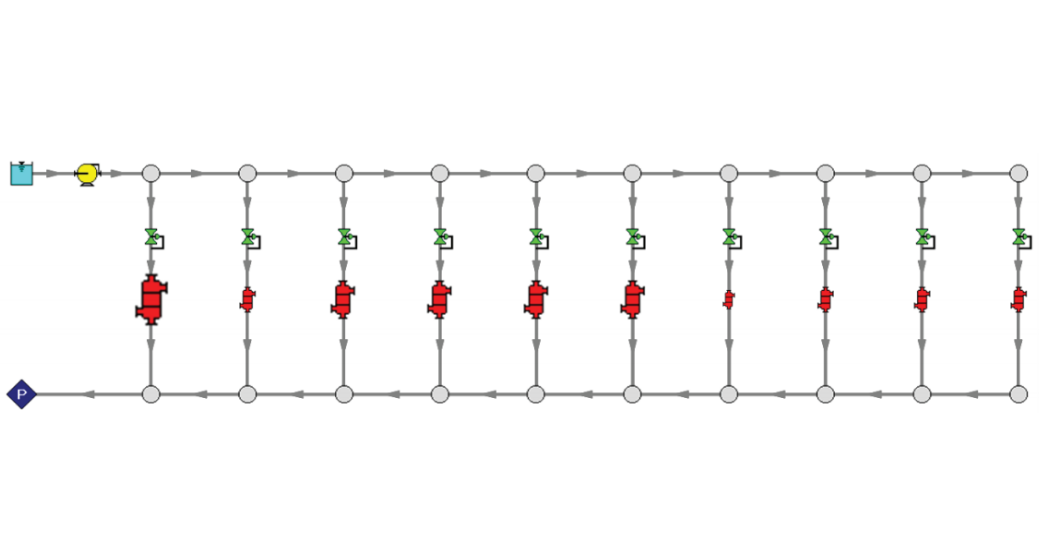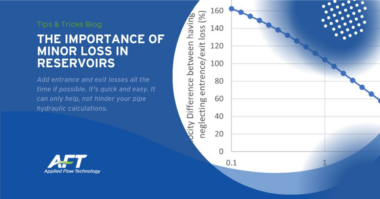Universidade Federal de São Paulo (UNIFESP)
São Paulo, Brazil
Platinum Pipe Honorable Mention: Operational Benefits & Sustainability
A large part of engineering is evaluating design tradeoffs. For example, in a pumping system, one pump option may be more efficient than others, but that efficiency often comes at larger initial cost. A less capital-intensive pump might be less efficient or have additional maintenance costs to consider. Similarly, system configurations have their own cost tradeoffs to consider.

Figure 1.2: Design Concept C2 –Single distribution header with secondary pump station following largest consumer.
Designing only for minimum energy use or minimum initial cost is unlikely to find an optimal solution due to these tradeoffs. Instead, minimizing the combined initial capital costs and recurring energy and maintenance costs is essential for optimal pump selection and system configuration.
Dr. Ricardo FF Pontes’ used AFT Fathom on his research with the Universidade Federal de São Paulo (UNIFESP) to explore pump and system configuration impact on system cost. Pontes’ cooling water loop system had 10 consumers of variable demand. The consumers ranged from 32 to 4,100 m3/hr (141 to 18,050 gpm) in cooling water demand, causing significantly different losses across their control valve elements.

Figure 1.3 Design Concept C3 – Separate pump stations and distribution headers isolating largest consumer.
Significant losses across a control valve represent large energy cost, since energy added from a pump is immediately spent through control valve losses.
Pontes’ research compared three configuration concepts (Figure 1 above). These concepts explored a singlepump, single-header system (C1), a single-header with additional booster-pump station (C2), and independent pump stations and headers isolating the major consumer (C3).
In each concept, Pontes optimized the number of pumps based on total cost, considering the pump’s material, installation, maintenance, and recurring energy cost. The pumps in each case were sized according to Fathom results, considering the number of pumps and associated cost (Table 1).

Table 1 Comparison of cost as number of parallel pumps increase, broken down into capital costs (material, installation) and recurring costs (maintenance, energy).
Costing was done within AFT Fathom, allowing for Pontes to consider both the initial pump and piping cost and discounted recurring energy costs. With a 10-year horizon, 10% interest rate, and 0.159 BRL/kWh (0.030 USD/kWh), it was found the isolated pump and distribution system (C3) saved 11% over the consolidated system (C1) and 7.6% over the booster-pump system (C2) (Table 2).

Table 2: Estimated total cost comparison of the three design concepts, revealing the isolated pump station and distribution system (C3) as the most effective option.
Pontes found the additional piping cost of an isolated distribution header was outweighed by reduced pump and energy costs. Additional sensitivity analysis on system lifespan, interest rate, energy cost, and order of consumers was performed in AFT Fathom, in all cases confirming the isolated system as optimal.
While Pontes’ research and conclusions were specific to this particular system, his approach and methodology can be applied to design other cooling water system alternatives.
With AFT Fathom’s built-in cost capabilities, not only can engineers evaluate the technical requirements of their system, but they can easily manage and evaluate alternatives to optimize for cost and energy. With additional tools like the Automated Network Sizing add-on module, sizing pipes specific to operation can further reduce system cost.
The University of São Paulo (USP) is a public university, maintained by the State of São Paulo and linked to the Secretariat for Economic Development, Science, Technology and Innovation (SDECTI). The talent and dedication of teachers, students and employees have been recognized by different world rankings, created to measure the quality of universities based on several criteria, mainly those related to scientific productivity.





Comments